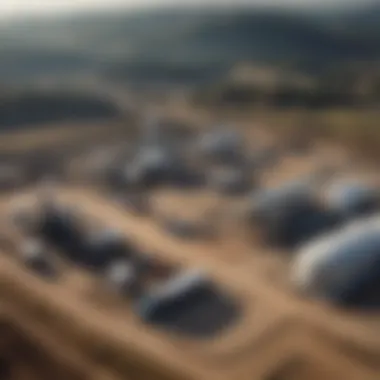Fracking Steps: An In-Depth Guide to Hydraulic Fracturing


Intro
Fracking, or hydraulic fracturing, has become a significant method for extracting oil and natural gas from deep underground. Understanding the process requires a close examination of its numerous steps, from site selection to the final monitoring after fracturing. This approach not only addresses the technical side but also brings to light the environmental and regulatory dimensions of this complex procedure.
The fracking process is often misunderstood, leading to misconceptions about its impacts. By breaking down the phases, we can gain a clearer view of how it operates and the implications it has on energy production and environmental sustainability. Each step is designed to maximize efficiency while addressing safety concerns, ensuring regulatory compliance, and minimizing the ecological footprint.
In this article, we will explore the key processes involved in fracking, emphasizing both innovations and traditional methodologies. The goal is to provide an informative guide that serves students, researchers, educators, and professionals seeking deeper insights into this pivotal energy extraction technique.
Understanding Fracking
The process of hydraulic fracturing, commonly referred to as fracking, is a significant topic due to its substantial impact on energy production and environmental concerns. Understanding fracking is crucial for comprehending its role in the energy landscape, especially as global demand for fossil fuels continues to rise. This section provides insights into fracking's definition, purpose, and historical context, offering a foundational knowledge that is essential for further exploration of the various phases involved.
Definition and Purpose
Hydraulic fracturing is the technique used to extract hydrocarbons from deep underground. This method involves injecting high-pressure fluid into rock formations to create fractures, thus allowing oil or gas to flow more freely to the wellbore. The primary purpose of fracking is to enhance the extraction efficiency of hydrocarbons, which can be trapped within impermeable rock layers. It has transformed the energy industry, enabling access to previously unreachable reservoirs and significantly increasing domestic production in countries like the United States.
This technique is not without its controversies. Critics often highlight environmental risks, including groundwater contamination and induced seismicity. However, proponents argue that fracking is a means to secure energy independence and reduce reliance on foreign oil. The balance of these perspectives leads to a complex discourse surrounding the practice, which is essential for understanding its application and implications in today's energy market.
Historical Background
The origins of hydraulic fracturing date back to the 1940s, with the first successful application occurring in 1947 at the Hugoton gas field in Kansas. Initially, the technique was simple, using sand and water to create fractures. However, the technology has evolved significantly over the decades. The introduction of horizontal drilling in the late 1990s marked a revolution in the field. This advancement allowed multiple fractures to be created along a single wellbore, vastly improving recovery rates.
In the early 2000s, large-scale fracking operations began in the Barnett Shale in Texas, spotlighting the efficacy and economic potential of the method. As production soared, so did concerns about environmental safety. This history underscores the balancing act between technological progress and sustainable practices.
Understanding these foundational aspects of fracking is essential. It sets the stage for analyzing subsequent phases of the process and their respective implications.
"The evolution of fracking reflects broader trends in the energy industry and invites discussions on its sustainability and safety."
Overall, the initial exploration of hydraulic fracturing highlights both its transformative role in the energy sector and the critical discussions regarding its environmental impacts.
Site Selection and Preparation
The process of hydraulic fracturing begins long before the drilling rig arrives on-site. Site selection and preparation are critical phases that can significantly affect both operational efficiency and environmental impact. These steps involve careful planning and analysis to ensure that the fracking process is not only effective but also compliant with regulatory demands and environmentally responsible practices.
Geological Assessments
Geological assessments are foundational to selecting a fracking site. These evaluations involve studying the geological formations to identify suitable rock types that will yield oil or gas. Key aspects include:
- Core Sampling: Extracting core samples from the subsurface to analyze rock properties.
- Seismic Surveys: Employing sound waves to map underground formations, revealing potential resource locations.
- Reservoir Characterization: Understanding the characteristics of the reservoir, including porosity and permeability, is crucial to determine its viability for fracking.
Accurate geological assessments guide decisions about where to drill. This minimizes risks and maximizes the potential recovery of hydrocarbons. Inadequate geological evaluations can lead to unsuccessful drilling operations, high costs, and unnecessary environmental disturbances.
Environmental Impact Studies
Conducting thorough environmental impact studies is vital in the planning phase of fracking operations. These studies assess how drilling could affect the local ecosystem and community. Noteworthy considerations include:
- Water Resources: Evaluating the availability and quality of water resources required for fracking.
- Land Use: Understanding land ownership and current land use practices to mitigate conflicts and disruptions.
- Ecosystem Assessment: Analyzing the potential impact on local wildlife and vegetation during both the construction and operational phases.
Proper environmental assessments help in recognizing risks, enabling the planning of mitigation strategies. This ensures the ecological integrity of the locality is preserved as much as possible.
Obtaining Permits
Obtaining necessary permits is a crucial step in the site selection process. Regulatory bodies impose requirements that must be met before any drilling activity can commence. Understanding the permit landscape is essential for compliance and operational success. Key points include:
- Local Regulations: Each state or locality has specific regulations governing fracking. Familiarity with these laws is essential.
- Public Consultation: Engaging with the community is often a requirement, fostering transparency and addressing concerns.
- Documentation: Substantial documentation, including environmental assessments and risk management plans, is typically required for permit approval.
Navigating the permit process can be complex and time-consuming. However, addressing these requirements early promotes smoother operations and lessens delays that could arise from legal challenges or community opposition.
Understanding the importance of site selection and preparation underscores the need for a methodical and conscientious approach to hydraulic fracturing. This phase sets the stage for all subsequent steps in the fracking process, influencing both economic outcomes and environmental sustainability.
Infrastructure Development
Infrastructure development is a critical phase in the fracking process, encompassing various elements that facilitate successful drilling and production. The significance lies in ensuring proper access and support systems for the fracking operations. Without adequate infrastructure, the entire project could face substantial delays and cost overruns.
Road Access and Site Facilities
Road access is essential for reaching remote drilling locations. These roads must be constructed robustly to accommodate heavy machinery and transport vehicles. Often, existing routes are not sufficient, requiring new access roads to be built. This process starts with assessing the terrain and analyzing the best paths for minimizing environmental impact. Specific guidelines also need to be followed to ensure compliance with local regulations.


Once access is established, site facilities are set up. These facilities provide necessary support for the workforce and equipment during the drilling process. Common components include temporary housing for workers, offices for operations management, and storage for equipment and supplies. Properly designed facilities help streamline operations and enhance safety.
Water and Waste Management Systems
Water management is a vital focus in the fracking process. As fracking requires large amounts of water for hydraulic fracturing, establishing effective water management systems is crucial. Sources of water must be identified beforehand, and treatment processes should be implemented to ensure the water meets the quality needed for fracking.
Moreover, managing wastewater generated during fracking is equally important. Wastewater contains various contaminants, making it necessary to treat it before disposal. This often involves specialized systems designed to separate water from solid waste, allowing for efficient recycling and reducing environmental harm.
"The infrastructure not only supports the operations but also minimizes the environmental footprint of fracking activities."
Proper infrastructure development ensures that these systems are in place, promoting efficiency while addressing potential environmental concerns. Overall, infrastructure development is fundamental, linking operational success to environmental responsibility in the fracking industry.
Drilling Phase
The drilling phase is a crucial component in the hydraulic fracturing process. This stage sets the groundwork for effective reservoir access, impacting both the efficiency of resource extraction and the overall success of the fracking project. Understanding the methods and technologies used during this phase is essential for grasping both the operational intricacies and potential outcomes of fracking.
Vertical Drilling Techniques
Vertical drilling represents one of the traditional methods employed in the fracking industry. In this technique, a well is drilled straight down into the earth to reach oil or gas reserves located beneath the surface. This method is typically less complex than its horizontal counterpart but serves as an effective method for accessing certain types of resources.
The main advantages of vertical drilling include:
- Simplicity: Vertical drilling systems can be simpler to design, implement, and maintain compared to more complex directional drilling techniques.
- Lower Costs: Generally, the cost associated with vertical drilling is lower, as it requires less advanced technology and fewer resources.
- Direct Access: For shallow reserves, vertical wells can provide direct access, maximizing recovery in certain geological formations.
However, while vertical drilling has its benefits, it can also present limitations. For example, the depth accessible to a vertical well is limited, restricting production potential. Additionally, this method might not effectively tap into the extensive horizontal reservoirs that are prevalent in many oil and gas fields today.
Horizontal Drilling Implementation
Horizontal drilling has transformed the fracking industry, allowing for more efficient resource extraction. In this method, the well does not simply go straight down but instead curves laterally within the rock layers. This angle provides access to a larger area of the reservoir, significantly enhancing the volume of oil or gas that can be recovered.
Notable features of horizontal drilling include:
- Increased Recovery Rates: By accessing more of the reservoir, this technique often results in higher yield and production rates compared to vertical drilling.
- Reduced Surface Impact: Fewer surface locations are required for wellheads, minimizing the environmental footprint of drilling operations.
- Access to Untapped Reserves: Horizontal drilling can navigate around geological obstacles and exploit reserves that are otherwise difficult to reach.
Despite its advantages, horizontal drilling can be more expensive and technically challenging than vertical drilling. The required technology and expertise can lead to increased costs and operational complexity. Nonetheless, the benefits in terms of yield and efficiency often outweigh these challenges.
"The choice between vertical and horizontal drilling depends on geological characteristics and desired extraction outcomes."
In summary, the drilling phase is pivotal to the fracking process. Vertical and horizontal techniques each play important roles, with specific advantages and limitations. An in-depth understanding of these methods will provide the necessary foundation for further exploration of the fracking process and its broader implications in energy production.
Fracturing Stage
The fracturing stage of the hydraulic fracturing process is crucial, as it directly impacts the successful extraction of hydrocarbons. This phase involves increasing the permeability of rock formations to allow oil and gas to flow more freely to the wellbore. Without this stage, the tight formations would remain largely impenetrable, limiting production. Therefore, understanding the intricacies of fracturing is essential for engineers and environmentalists alike.
Fluid Preparation and Composition
The fluids used in fracking are specially formulated to optimize the process. Fluid preparation begins with the selection of base fluid, commonly water or a water-based solution, augmented with various additives. These might include:
- Proppants: Materials such as sand or ceramic that help keep fractures open.
- Viscosity modifiers: Compounds that regulate flow rates, allowing the fluid to travel further into the rock.
- Biocides: Added to prevent bacterial growth, which might create complications in the well.
- Surfactants: Facilitate the flow of fluid into the fractures.
The correct composition of these additives is essential to maintain the integrity and effectiveness of the fractures. An optimal balance minimizes formation damage while maximizing the extraction of energy resources.
Injection Techniques and Pressure Management
Injection techniques in the fracturing stage involve complex methodologies to optimize the pressure. It is key to implementing precise strategies to manage the pressure of the injected fluid. There are a few important considerations:
- Injection Rate: The speed at which the fracking fluid is injected must be controlled to prevent fracturing beyond the desired zones. High rates could lead to uncontrolled fractures that might compromise the formation.
- Pressure Levels: Managing the pressure is vital to ensure that the rock fractures expand without risk of collapse. The pressure is continuously monitored, adjusting the injection as necessary to respond to changes in the rock behavior.
- Cycle Timing: Injection is often performed in cycles, allowing for intervals, where pressure is maintained, or fluid is allowed to flow temporarily to determine the effectiveness of the fractures.
Effective management of injection pressure can significantly influence recovery rates and overall efficiency in hydrocarbon extraction.
Post-Fracturing Process
The post-fracturing process is a critical phase in the hydraulic fracturing operation, impacting both environmental outcomes and well productivity. It refers to the activities and management strategies subsequent to the fracturing stage, including flowback and data collection. Ensuring effective post-fracturing procedures is essential for mitigating ecological risks while maximizing the benefits of extracted resources.
Flowback and Produced Water Management
After the fracturing fluid is injected into the well, a mixture of this fluid and formation water returns to the surface. This is known as flowback water. Effective management of flowback and produced water is vital due to the potential contaminants it can carry. These contaminants may include chemicals used during fracking, hydrocarbons, and salts, making the water unsuitable for direct discharge into the environment without treatment.
To address these challenges, several best practices are recommended:


- Treatment Solutions: Employ techniques such as reverse osmosis or advanced oxidation to treat contaminated water, ensuring safe release or reuse.
- Storage Facilities: Construct robust containment structures to safely store flowback water before it undergoes treatment.
- Disposal Options: Explore environmentally sound disposal methods, including underground injection wells, ensuring compliance with regulatory standards.
"Managing flowback and produced water efficiently can significantly reduce the ecological footprint of fracking operations."
The main goal is to reduce risks associated with water contamination and to bolster public acceptance of fracking projects by demonstrating a commitment to responsible resource management.
Well Monitoring and Maintenance
Post-fracturing well monitoring and maintenance are crucial for ensuring the longevity and operational efficiency of the well. It involves systematic checking of the well integrity and production rates over time. By monitoring wells after fracturing, operators can identify potential issues that could arise, such as fractures leaking gas or fluids into unintended areas.
Several strategies can improve monitoring and maintenance efforts:
- Regular Inspections: Conduct visual inspections and use technology such as sensors to monitor pressure and temperature in the well.
- Data Collection: Gather and analyze data regarding production levels and flow characteristics to inform maintenance schedules.
- Swift Response Protocols: Establish protocols to address anomalies quickly, mitigating risks of environmental impact.
The importance of this stage lies not just in maximizing output, but also in ensuring safety and minimal environmental disruption. Proper maintenance practices allow operators to optimize production while upholding regulatory compliance. By implementing diligent monitoring and maintenance, the overall sustainability of hydraulic fracturing can be improved.
Economic Implications of Fracking
The economic implications of fracking are significant and multifaceted. As hydraulic fracturing has transformed the energy landscape, it has also impacted local, national, and global economies. Understanding these implications can help stakeholders make informed decisions regarding energy production, environmental responsibility, and economic development.
Fracking has contributed to job creation, economic growth, and energy independence for many regions. Through the establishment of oil and gas wells, numerous employment opportunities arise, benefiting local workers and supporting various industries. The influx of capital investment stimulates growth in related sectors, such as transportation, equipment manufacturing, and service industries.
However, while the economic benefits are evident, there are still critical considerations. The balance between economic gain and environmental impact often raises concerns among communities. As the technology continues to evolve, it becomes vital to analyze both short-term and long-term economic factors involved in the fracking process.
Cost Analysis and Investment
Cost analysis plays a crucial role in determining the feasibility of fracking projects. The initial investment required for drilling, site preparation, and infrastructure can be substantial. Companies must carefully evaluate these costs against potential revenue from extracted oil and gas. Here are some key factors influencing investment costs:
- Land Acquisition: Securing land for drilling can incur high costs, especially in competitive markets.
- Technical Equipment: Advanced drilling rigs and hydraulic fracturing equipment represent a significant portion of initial investment.
- Labor Costs: Skilled labor is essential for the successful operation of drilling and fracturing processes.
- Permitting Fees: Obtaining necessary permits can add to the overall cost, affecting project timelines and profitability.
Assessing these costs allows companies to strategize their investments and minimize financial risks.
Market Dynamics and Energy Prices
The relationship between fracking and market dynamics is complex, as global energy prices can fluctuate based on supply and demand. The introduction of fracking has led to increased production levels, often resulting in lower energy prices. Factors influencing this dynamic include:
- Supply Levels: As fracking enables the extraction of previously inaccessible resources, supply increases can lead to price declines.
- Demand Fluctuations: Changes in consumer demand for energy affect pricing. Economic growth phases may bolster demand, while downturns might reduce it.
- Global Competition: The emergence of fracking in various countries increases competition within the global market, influencing prices.
- Regulatory Changes: Environmental regulations can impact production costs and, in turn, energy prices.
Understanding these dynamics is essential for predicting market trends and evaluating future energy investments.
Environmental Considerations
Understanding environmental considerations within the context of fracking is essential. The process of hydraulic fracturing, while designed to enhance energy production, involves numerous environmental elements that necessitate careful evaluation. Acknowledging these elements promotes responsible practices and minimizes adverse impacts on ecosystems and communities.
Potential Environmental Risks
The potential environmental risks associated with fracking can be significant. These risks include contamination of groundwater, surface water pollution, and ecosystem disruption. Each factor can lead to serious consequences for local wildlife and human populations.
- Groundwater Contamination: One of the foremost concerns is the possibility of harmful chemicals infiltrating groundwater sources. This contamination can arise from inadequate sealing of well casings or from spillage during transport.
- Surface Water Pollution: Wastewater generated during fracking often presents a danger to rivers and streams. If not managed properly, toxins can enter the water supply, affecting aquatic life and human health.
- Air Quality Degradation: Emissions from equipment and gas venting can contribute to air pollution. These pollutants include volatile organic compounds (VOCs) that may harm respiratory health and overall environmental quality.
"The consequences of neglecting environmental risks can extend well beyond the life of the well, affecting generations to come."
The local ecosystem may also suffer disruption during the drilling process. Habitat destruction is a common issue when clearings are made for well sites, leading to a decline in biodiversity.
Regulatory Frameworks
Addressing the environmental risks posed by fracking is heavily reliant on regulatory frameworks established to govern the industry. These frameworks create guidelines and regulations to mitigate negative impacts. Regulations vary by region, reflecting local environmental conditions and community needs.
- Federal and State Regulations: In the United States, agencies like the Environmental Protection Agency (EPA) set national standards. However, states often have their own specific regulations that can enhance federal guidelines or adapt them to local contexts.
- Permitting Processes: Before any fracking operation can begin, companies must go through a rigorous permitting process. This typically involves assessments of environmental impacts, public consultations, and adherence to regulatory requirements to avoid compromising the environment.
- Monitoring and Compliance: Regulatory frameworks also enforce monitoring of fracking activities. This ensures companies comply with environmental standards and address any violations promptly.
Public Perception and Advocacy
Understanding public perception and advocacy surrounding fracking is critical in assessing the future of this controversial energy extraction method. The viewpoints held by communities and stakeholders can significantly influence regulatory policies, industry practices, and overall acceptance. By analyzing public sentiment, one can grasp the complexities involved in fracking's role in the energy sector.
Grassroots Movements and Lobbying
Grassroots movements have emerged as powerful forces in shaping the public discourse around fracking. Organizations such as Food & Water Watch and the Sierra Club mobilize local communities to express their concerns. They often focus on environmental risks, including water contamination and air quality. These groups leverage social media platforms to amplify their messages, gain visibility, and encourage public involvement.
Lobbying efforts are also prominent. Industry proponents often seek to sway public officials in favor of fracking, arguing its economic benefits. This creates a dual narrative—one that emphasizes job creation and energy independence, against one that raises alarms about environmental repercussions.


Media Representation of Fracking
Media representation plays a significant role in shaping public perception of fracking. The portrayal of the practice in news outlets varies widely, influencing how the public views fracking. Reports highlighting incidents of contamination or adverse health effects tend to evoke fear and opposition. Conversely, articles focusing on the economic advantages or energy contributions often foster support for fracking activities.
Consider the following points in media narratives:
- Framing the Debate: Media can frame fracking as either a crisis or a necessity, which can alter public opinion.
- Use of Scientific Data: The inclusion of scientific research can lend credibility to concerns or benefits presented.
- Diverse Voices: Incorporating opinions from both opponents and supporters can create a more balanced narrative.
In the battle of narratives, the media wields significant power. It shapes perceptions, which can ultimately determine the fate of fracking regulations and practices.
Technological Innovations in Fracking
Technological innovations play a crucial role in the evolution of hydraulic fracturing practices. As the demand for energy continues to rise, so does the need for efficient and effective extraction methods. These innovations not only enhance the performance of fracking processes but also help in minimizing environmental impacts and reducing operational costs. This section explores two significant advancements: drilling equipment and emerging techniques in fluid dynamics.
Advancements in Drilling Equipment
The efficiency of fracking largely depends on the equipment used during the drilling phase. Recent advancements in drilling technology have led to the development of automated drilling rigs, which are more precise and reduce human errors. These rigs can adjust in real-time to geological variations, optimizing drilling paths and maintaining safety standards.
Moreover, new bit technologies, such as polycrystalline diamond compact bits, can penetrate harder rock formations more effectively. This capability not only speeds up the drilling process but also reduces the overall resource consumption, leading to lower costs.
Another important development is the use of telemetry systems. These systems allow engineers to collect and analyze data from the field in real time. With this information, they can make informed decisions about drilling strategies and quickly address any issues that arise during the operation.
"The integration of advanced drilling technologies is paving the way for a more sustainable and efficient energy extraction process."
Emerging Techniques in Fluid Dynamics
Fluid dynamics is another area where innovation has significantly impacted fracking. The composition and behavior of fracturing fluids can influence the efficiency of the fracturing process. The use of smart fluids, which can change their properties under different conditions, is gaining popularity. These fluids can increase the effectiveness of the fracture network, ultimately leading to higher production rates.
Additionally, researchers are exploring more environmentally friendly fluid alternatives. Biodegradable additives are replacing traditional chemicals, thus reducing the ecological footprint associated with fracking operations.
Microbial-enhanced oil recovery techniques are also emerging. These methods employ microorganisms to improve fluid flow in reservoirs, thereby assisting in the extraction of oil and gas from previously unrecoverable areas.
Global fracking Practices
Fracking, or hydraulic fracturing, has become a significant method for extracting hydrocarbons globally. Its practices vary widely depending on regional geology, regulatory environments, and technological advancements. Understanding these global practices is essential as they illustrate the complexity and adaptability of fracking techniques. This section emphasizes the importance of examining these practices to grasp the nuances and impacts of fracking on a worldwide scale.
Fracking Methods Variability by Region
The methods used in hydraulic fracturing are influenced by geology, resource availability, and local regulations. For instance:
- United States: The U.S. is a frontrunner in the use of fracking, particularly in shale deposits such as the Bakken and Eagle Ford. The approach is often characterized by advanced horizontal drilling techniques, allowing access to extensive reserves.
- Canada: Canadian fracking is heavily regulated. Most operations focus on both natural gas and oil extraction from shale formations. Techniques are often adapted based on environmental standards aimed at minimizing ecological disruption.
- Europe: Fracking in Europe faces significant public opposition and stricter regulations, particularly in countries like France and Germany. Although there is potential for shale gas extraction, many nations have opted for cautious approaches, thus limiting the use of fracking methods.
- Asia-Pacific: Countries like China have rapidly expanded fracking operations to meet energy demands. However, technological and environmental challenges remain prominent, affecting the effectiveness and safety of fracking practices.
"The variability of fracking methods is a testament to how localized concerns shape energy extraction."
Each region adopts different processes based on these factors, leading to disparities in efficiency, economic impacts, and environmental consequences.
International Regulations and Standards
Regulatory frameworks governing fracking are crucial for ensuring the safe and responsible extraction of resources. Different countries have developed various standards aimed at mitigating environmental risks and protecting public health. The contrasts in regulatory policies impact how fracking is perceived and practiced internationally. Key considerations include:
- Environmental Impact Assessments (EIAs): Many countries mandate comprehensive EIAs before any fracking operation begins. This helps to evaluate potential effects on ecosystems and communities.
- Water Management Regulations: Regulations governing water usage vary. In some regions, strict limits on water extraction for fracking help to protect local water resources.
- Well Integrity Standards: Standards for well construction and maintenance are vital to prevent leaks and contamination. Countries like the U.S. often require strict adherence to these standards.
- Public Reporting and Transparency: Some jurisdictions necessitate that companies disclose the chemicals used in fracking fluids. This transparency is intended to inform communities and foster accountability.
The differences in international regulations reflect a broader dialogue around environmental stewardship and energy production. As fracking continues to evolve, global practices must adapt to enhance compliance with effective standards.
Future of Fracking
The discussion surrounding the future of fracking is crucial in framing the ongoing transformation within the energy sector. This segment looks into projected trends, technological progress, and hurdles that accompany the evolution of hydraulic fracturing practices. As dependency on fossil fuels continues to face scrutiny, understanding the road ahead for fracking becomes vital for stakeholders involved in energy production and environmental safeguarding.
Trends in Energy Production
Several emerging trends characterize the future landscape of energy production through fracking. Key among them is the shift toward increased efficiency of extraction techniques. Companies are constantly refining their methods, utilizing advanced technology such as data analytics to optimize well placement and production rates. The integration of artificial intelligence can enhance decision-making processes to maximize resource extraction while minimizing costs.
Another trend is the growing inclination towards renewable energy sources. As countries commit to reducing their carbon footprints, there will be a more concerted effort to balance fossil fuel extraction with sustainable practices. Fracking, while still valuable, may increasingly be viewed as a transitional phase toward greater sustainability in energy production.
Economic models are also evolving. Investors and energy companies are adapting to market dynamics that favor green technologies. Thus, firm policies exploring carbon capture and storage technology can create a more sustainable approach for future fracking initiatives. The adaptability of the industry in response to these financial shifts could determine its longevity and relevance.
Sustainability Challenges
Despite its advantages, fracking faces sustainability challenges that could impact its future viability. One significant concern is environmental degradation. The process can lead to contamination of local water sources, which remains a contentious issue. As awareness of these risks heightens, stricter regulations are likely to be implemented, influencing how fracking is conducted.
Additionally, there exists a pressing need for transparency and public engagement. As community concerns rise around the safety and environmental implications of fracking, companies must establish better communication channels with local populations. Maintaining trust through transparent operations is essential for the industry's sustainability.
Finally, there is the issue of climate change. Policymakers and environmental activists are pushing for a reduction in greenhouse gas emissions. Although fracking may provide a bridge to cleaner energy, it still contributes to carbon emissions. This dichotomy raises questions on the industry’s role in the larger climate framework.
"Sustainability in fracking practices will determine not only the future of energy production but also the overall impact on our environment."















